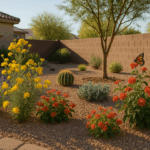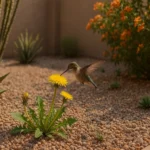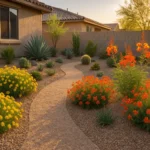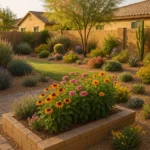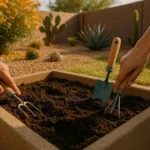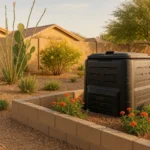As a passionate gardener based in the charming city of Gilbert, I’m thrilled to share my knowledge about desert pollinators – bees and butterflies – and how to attract them into your garden. It’s not just about adding beauty to your yard. Encouraging these creatures to visit your garden is vital for a healthy ecosystem and successful plant growth. Let’s delve into understanding these fascinating desert pollinators and the specific plants they love.
Understanding Desert Pollinators
A desert ecosystem is a unique and fragile environment that relies heavily on its native pollinators. The bees and butterflies you see fluttering around your Gilbert backyard are not just beautiful creatures; they play a crucial role in the survival and propagation of many desert plants. They transfer pollen from male to female flowers, ensuring fertilization and the production of fruits and seeds.
But why are these pollinators so important? They are a key component of biodiversity, contributing to the health and vitality of the ecosystem. In addition, they support the growth of trees and flowers that provide habitat and food for other wildlife. Their absence could disrupt the balance of our local environment, leading to a decline in plant species and a loss of food for other animals.
Attracting Bees to Your Gilbert Garden
Bees are one of the most effective pollinators, and enticing them to your garden can significantly boost your plants’ health and productivity. The key to attracting bees to your Gilbert garden is to plant a variety of native flowering plants that provide nectar and pollen throughout the year.
Desert Marigold (Baileya multiradiata) is a beautiful, hardy perennial that flourishes in the harsh Gilbert climate. Its bright yellow flowers are a favorite of bees, and it’s a perfect plant for a low-maintenance garden. Another excellent choice is the Red Fairy Duster (Calliandra californica), a shrub that produces red flowers throughout the year, providing a consistent food source for bees.
Remember, bees are attracted to a variety of colors and shapes, so aim to have a diverse range of flowering plants in your garden. And, avoid using pesticides as they can harm bees and other beneficial insects.
Inviting Butterflies to Your Desert Garden

Butterflies add a touch of magic to any garden, and they also play an important role in pollination. Their preferences differ slightly from bees, so it’s worth considering a separate set of plants to attract butterflies.
Butterfly Bush (Buddleja davidii) is a fantastic choice for your Gilbert garden. This deciduous shrub produces clusters of sweet-scented flowers that butterflies find irresistible. Another great option is the Desert Milkweed (Asclepias subulata) – a must-have for any butterfly garden. As the name suggests, it’s a favorite of Monarch butterflies, providing both food and a safe place for their larvae to grow.
Butterflies are also drawn to puddling areas where they can drink and extract minerals from the soil. Consider adding a shallow dish filled with damp sand to your garden to create a butterfly-friendly space.
Creating a Pollinator-Friendly Garden in Gilbert
Creating a pollinator-friendly garden is a rewarding endeavor that contributes positively to the local Gilbert ecosystem. Here are some additional tips to help you create a garden that bees and butterflies will love:
- Plant in clusters: Bees and butterflies are more likely to visit large patches of the same flower. Planting in clusters also makes your garden more visually appealing.
- Provide a water source: Pollinators need to drink too. A shallow dish with fresh water and a few stones for them to land on will suffice.
- Maintain year-round blooms: To attract and support pollinators all year, ensure there are plants that bloom in different seasons.
- Use native plants: Native plants are more likely to attract local pollinators because they have evolved together. They’re also more resilient and require less maintenance.
By implementing these tips and planting the right flowers, your Gilbert garden will soon be a buzzing, fluttering oasis for desert pollinators. Not only will you enjoy the added color and activity, but you’ll also be doing your part to support our local ecosystem. Happy gardening!

